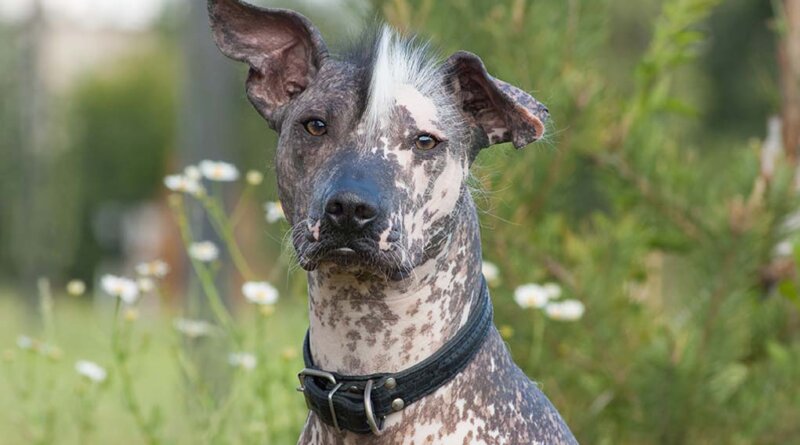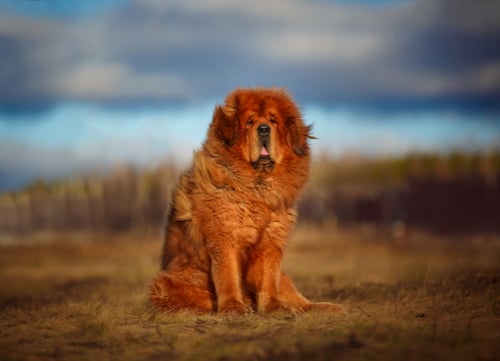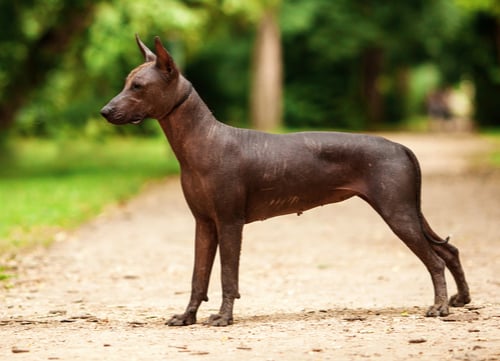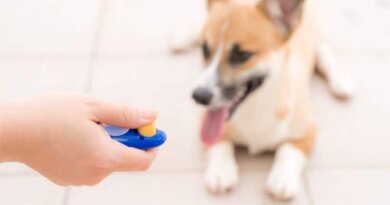11 Most Popular Exotic Dog Breeds In the US
Does the thought of being the twentieth person in your neighborhood to get a Lab make you itch? Do you feel more comfortable marching to the beat of your own drum? Are you always in search of something different, something out of the ordinary? If you answered “yes” to any of those questions, then maybe an exotic dog breed is the best fit for you.
What makes a dog exotic? Often the breed is rare or comes from a faraway place. Or maybe it’s just uncommon in the United States. According to the American Kennel Club rankings for 2020 (based on the 2019 registrations), the following eleven exotic dog breeds are the most popular in the United States.
1. Shiba Inu
This fox-like dog climbed to number 45 this year. The ancient Japanese breed was developed around 300 B.C. to hunt large game in rough, mountainous terrain. Today, the Shiba Inu is the top companion dog in Japan.
This confident dog can adapt to living either in cities or rural areas. Good-natured, the Shiba Inu forms close bonds with family but is reserved with strangers. This breed has a lot of energy, but daily walks will be enough if the Shiba Inu doesn’t have a fenced-in yard to run in. While these dogs can be a challenge to train, they’re easy to housebreak. The Shiba Inu’s coat requires little grooming, just regular brushing.
2. Shar-Pei
Trotting in at 65, this unique-looking dog has tiny ears perched on the head, an upturned tail, and wrinkles everywhere. The ancient Chinese breed was developed around the time of the Han Dynasty, and depictions of these dogs appear on artifacts. Chinese farmers used the breed as herders, livestock guardians, and hunters. The name “Shar-Pei” means “sand skin,” a description of the breed’s rough, coarse coat. In 1949, the breed was nearly exterminated when the People’s Republic of China announced a ban on dog ownership and shot any stray dogs found. Fortunately, a few Shar-Peis survived in Hong Kong and Taiwan.
Loyal to family, the Shar-Pei doesn’t do well with strangers and other dogs. Grooming needs are minimal with just the occasional bath. The Shar-Pei is adaptable when it comes to exercise. This dog is happy to either go out with an active owner for long walks every day or live in an apartment with fewer, shorter walks. The Shar-Pei can also participate in dog sports like obedience, tracking, and agility. With these dogs, early socialization and training is crucial because of their protective instincts and desire to be in charge.
3. Basenji
At 87 in the rankings, this adaptable, laidback dog doesn’t bark but yodels or chortles instead. The ancient Egyptian breed appears on the tombstones of pharaohs. Although bred as hunting dogs, the basenji today is more likely to be a companion.
Basenjis care about being clean and groom themselves like cats. They don’t have a “doggy”odor but do shed. Weekly brushings are generally enough to maintain their coats.
These dogs, like other sighthounds, have a lot of energy and prefer to exercise with active owners. Basenjis are intelligent but also independent, so they can be a challenge to train.
4. Leonberger
This huge dog lumbers in at 95 in the rankings. This cross between a Newfoundland, St. Bernard, and a Great Pyrenees can be intimidating; an adult male may weigh up to 170 pounds. The name comes from the city of Leonberg in Germany, where the breed originated. This lion-like dog was a royal hit: the King of Italy, Czar of Russia, and Prince of Wales all owned Leonbergers.
Affectionate and easy-going, these dogs get along well with children. Their coat needs brushing every day because it mats. Leonbergers have a lot of energy to expend, so they need vigorous exercise daily. These dogs enjoy running with their owners or alongside a bike. They also excel at agility training.
These friendly giants benefit greatly from early socialization and ongoing training.
5. Borzoi
These sighthounds, also called Russian Wolfhounds, race in at rank 105. The Russian aristocracy bred them to hunt wolves in events every bit as social and structured as the British fox hunts. With the Russian Revolution, not only was the aristocracy slaughtered but so were their hounds. The breed survived because fans had begun breeding the dog in countries outside of Russia. The name “Borzoi” comes from the Russian word “borzyi,” which means “swift.” This regal-looking dog—imagine a greyhound’s graceful frame covered by a glamorous long coat—can reach speeds of 35 to 40 miles per hour.
These dogs are calm and affectionate with their people. They don’t require much grooming, just a quick brushing every day or every other day and regular baths. These dogs need daily exercise, such as long walks or runs in a fenced-in yard. As is typical for sighthounds, they will chase small animals so cannot be let off-leash. They excel in dog sports such as agility and lure coursing.
6. Saluki
The Saluki, sometimes called a Persian Greyhound, places at 125 in the rankings. Sources disagree on how old this ancient Egyptian breed is, but the consensus suggests they date back to 6000 or 7000 B.C. Bred to hunt gazelle, hare, fox, and jackal, this dog is fast. Only a Greyhound can exceed a Borzoi’s speed. Kept by Egyptian pharaohs to hunt, these dogs were sometimes mummified with their owners to accompany them into the next world.
Loyal, these dogs form strong bonds with their people. Although this dog is gentle, he doesn’t do well in a house with small animals. The Saluki requires weekly brushing and does not have a “doggy” odor. Like most sighthounds, the Saluki needs a lot of exercise. They excel in dog sports like flyball and lure coursing.
Early socialization and training is important because the Saluki tends to be stubborn and reserved around new people.
7. Tibetan Mastiff
At rank 128, this large dog can weigh 100 to 160 pounds and stand 26 inches high at the shoulder. The breed’s deeply set, wise eyes makes it easy to understand why Tibetans believed these mastiffs were reincarnated monks and nuns. Because Tibet has traditionally been isolated, no one knows for sure how old this breed is. Bred in the Himalayan mountains, the dog’s heavy coat helped it to survive the frigid temperatures of winters in Central Asia. These dogs may be ancestors of modern mastiffs, spreading across the world when they were given as gifts to foreign travelers, who then developed the breed in their own countries.
While Tibetan Mastiffs are laidback and friendly to their people, they are wary of strangers. Strongly territorial, they make excellent watchdogs. Most of the year, grooming needs are minimal, just brushing two or three times a week. When the dogs blow their coats annually, de-shedding tools may be required.
Tibetan Mastiffs need regular exercise but experience short bursts of energy rather than having a lot of stamina. They prefer to work—perhaps patrolling the perimeter of their territory—rather than play. These dogs can be a challenge to train because they are independent and should never be allowed off-leash in an open area.
8. Xoloitzcuintli
This dog with the long difficult name (pronounced as “show-low-eats-QUEENT-lee”) comes in at 137. The breed’s name derives from two Aztec words: “Xolotl,” which is the name of an Aztec god and “itzcuintli,” the word for dog. The Aztecs believed this breed belonged to the god Xolotl and could protect them from evil spirits and human enemies. The Aztecs sacrificed these dogs when their owners died so they could continue to protect their owners and guide them to the next world. Representations of these dogs have been found in Aztec, Mayan, and Toltec tombs, dating back 3000 to 3500 years ago.
Also called the “Mexican Hairless Dog” for their tough, smooth skin, these dogs are muscular, with a sweet, intelligent expression. They come in three sizes (toy, miniature, and standard) and two varieties: hairless or with a short coat. The hairless variety is a good choice for people with allergies, and these dogs need sunscreen if they’re going to be outside for long. The short coat on the other variety requires little upkeep, just a weekly brush and occasional baths.
The Xoloitzcuintli makes an affectionate companion and a good watchdog, who barks only to alert. These dogs are calm in the house but need ample exercise, consisting of long walks and structured playtime. They benefit from early socialization and training.
9. Dandie Dinmont Terrier
Ranked at 174, this terrier is rare today, with only a few hundred registered a year. This breed looks like a conglomeration of dogs: imagine a large poodle head with a terrier’s face on top of a fluffy dachshund body. Originating around 1700, farmers kept these odd-looking dogs to hunt rats and badgers. They are the only breed registered with the American Kennel Club named after a fictional character. Scottish novelist Sir Walter Scott created a character named Dandie Dinmont in Guy Mannering who kept these working terriers. The name stuck for the breed itself.
These intelligent dogs can adapt to city living or life in the country. They make good watchdogs, with a big bark for their size. They enjoy playing with children. These dogs need daily brushing to avoid matting, and their coat must be stripped of dead hair by a professional groomer or owner a few times a year.
Dandie Dinmont terriers require a half hour or so of exercise twice a day. Going for a walk or chasing a ball in a fenced yard should be enough activity. They will chase small animals so can’t be let off leash. These terriers benefit from early socialization and training; they are independent but eager to please their people.
10. Bergamasco
This sheepdog, bounding in at 180, looks like he’s wearing a shaggy, textured carpet. The coat consists of hair with three different textures (called “dog,” “goat,” and “wool”). The textures weave together, creating mats called “flocks.” The flocks protected the dog from the fierce cold of the Italian Alps and attacks from large predators looking for sheep. The sheepdog was bred for power and agility to herd and guard sheep in the craggy mountains. The name originates from Bergamo, a town in the Alps.
Extremely social, the Bergamasco gets along well with children and other animals. These gentle, protective dogs love their people but can be reserved with strangers, making them good watchdogs. Their unique coat doesn’t shed and needs surprisingly little care. When the sheepdog is a year old, the “goat” and “wool” hair will grow in, and the coat must be ripped into mats. Those mats continue to grow, requiring no further maintenance or brushing.
Bergamascos need moderate daily exercise. Because they bond closely with their people, exercise should be with them, not alone. These dogs enjoy playing fetch, going for a brisk walk or hike, or running with their people in a fenced backyard. Bergamascos have an agreeable personality, which makes them trainable, although they can be independent. They will benefit from early socialization and training.
11. Azawakh
Our last dog on the list, coming in at 190, hails from the West African countries of Burkina Faso, Mali, and Niger. Their name comes from the Azawakh Valley where many are found. These tall, elegant dogs live with Tuareg nomads as part of the family, protecting settlements and livestock. This ancient breed goes back more than a thousand years and was bred to hunt hare, antelope, and wild boar in the hot, dry climate.
These beautiful dogs are affectionate and loyal with their people. The short coat doesn’t require much maintenance, perhaps a once-a-week brush or use of a hound glove or grooming mitt. Since Azawakhs don’t have a “doggy” odor, they need only an occasional bath.
For exercise, these dogs want company. They enjoy daily runs with their owner or active playtime in a fenced backyard. Because this breed is so independent, socialization and training needs to start early with a trainer who uses positive, rewards-based training.
All of the exotic dogs on this list make good companions for people who appreciate the unusual in life.














